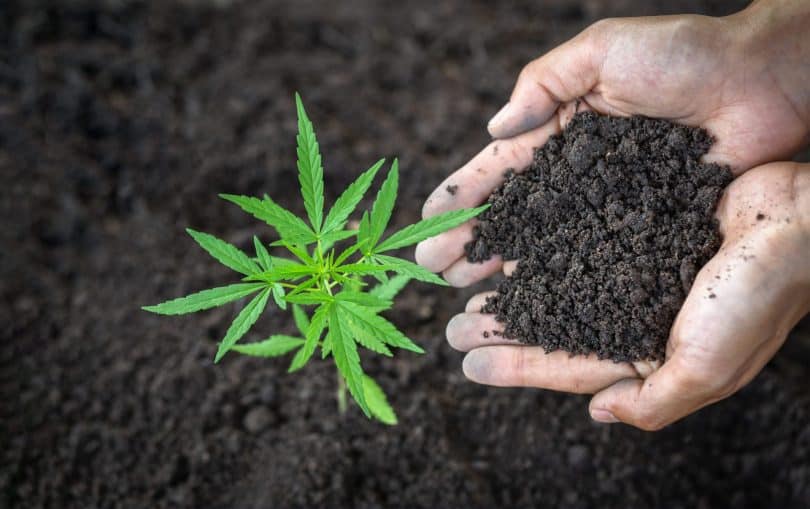Each year, more states pass laws to legalize the recreational use of marijuana. On top of the 18 states that already have recreational use laws, even more states have legalized marijuana for medicinal purposes. Nearly every state that has laws like these allows people to grow their own cannabis plants at home.
The best way to grow high-quality cannabis at home is to start from seeds, and there are plenty of cannabis seeds available here. Cannabis plants are fairly easy to grow, which is how they got the nickname “weed.” To get the best quality buds, there are some basic requirements that need to be met, which are explained in greater detail below.
Contents
Container
When first setting up a home grow it is important to consider where the plants will be spending most of their time. If the setup is outdoors, the seeds can be planted directly in the ground. If growing indoors, they must be planted in containers.
Cannabis plants require at least four to five gallons of soil and deep waterings every two to three days. If planting in the ground, the amount of soil the plant has access to is rarely limited. If growing plants in a container, it is important to get one large enough to handle both the weight and volume of that much soil and water.
Soil
Cannabis plants require a heavy dose of nutrients to flourish, so the soil must be high quality. While the plants need water frequently, they do not like to have their roots sit in moisture for too long. Soil mixes with a composition of at least 40% perlite are ideal.
There are cannabis-specific soil mixes available that can help take the guesswork out of choosing soil. Never use soil mixes that contain fertilizers, as these are rarely added in the right ratios for growing cannabis. Stick to organic mixes that contain a combination of the aforementioned perlite, organic compost, and either coco coir or peat moss.
Light
Regular cannabis plants need 16 to 18 hours of light throughout the vegetative stage and will transition to the flowering stage after they receive less than 12 hours of light per day. Autoflowering plants transition to the flowering stage without changes in light. They also take much less time to grow than their photoperiodic cousins.
If growing cannabis outdoors, then Mother Nature will do all of the light work on her own. If growing them indoors, it is important to invest in a high-quality, full-spectrum grow light. Consider operating the light on a timer so the light schedule is consistent.
Nutrients
Cannabis plants are heavy feeders and will require growers to fertilize them regularly. Since growing cannabis at home has risen in popularity, there has also been an increase in the number of nutrient solutions that are designed specifically for growing cannabis. Use one of these nutrient solutions and follow the directions on the label for best results.
During the vegetative stage, cannabis will need nutrients that are high in nitrogen to help the plant grow taller and produce leaves. During the flowering stage, the level of nitrogen should be reduced and the amount of phosphorus should be higher. Phosphorus is the primary nutrient that promotes bud growth.
Germinating Cannabis Seeds
Cannabis seeds can be germinated in different ways. The easiest and simplest method is to plant the seed directly in the soil where the plant will grow. Be sure to keep the soil moist and warm until the seedling emerges from the dirt, which should take about one week.
Another method for germinating cannabis seeds is to wrap them in a paper towel that is soaked in distilled water, put them in a container, and store the container in a warm place. Check the seed every day to see if a taproot has emerged. Once that happens, the seed will need to be carefully moved into the selected growing medium.
Vegetative Stage
After the seed is germinated and transferred to a new pot, it will technically be in the vegetative stage. After about a week of growth, once the first set of true leaves is fully formed, it is time to start adding nutrients. Once the plant has developed four to five sets of true leaves, it should be transferred to its final growing pot.
If growing autoflowering seeds, then germinated seeds should be transplanted directly into their final growing pots. Autoflowering seeds have a much shorter life cycle and do not have time to recover from the shock of being transplanted. It is best to minimize the amount of stress these plants experience to get the highest-quality buds.
Flowering Stage
Cannabis plants will enter the flowering stage as soon as the light amount of light they receive is less than 12 hours. For autoflowering plants, this typically happens automatically after two to four weeks regardless of the light. The plant will not look as though it is flowering at this point, but it is nonetheless.
At this point, the nutrient solution given to the cannabis plants should be transitioned slowly from the nitrogen-heavy solution to the phosphorous-heavy solution. Be sure to adjust the solution gradually to avoid shocking the plant. This is especially true for autoflowering cannabis seeds, as shocking an autoflower plant can have devastating results. The flowering stage will be finished and the buds will be ready to harvest once most of the pistils are completely brown.
Grow Your Own Cannabis Seeds
Cannabis is a tolerant and adaptable plant, so following the instructions above should get even the most novice growers off to a good start. Be sure to buy high-quality cannabis seeds from a reputable seed bank for the best results.







